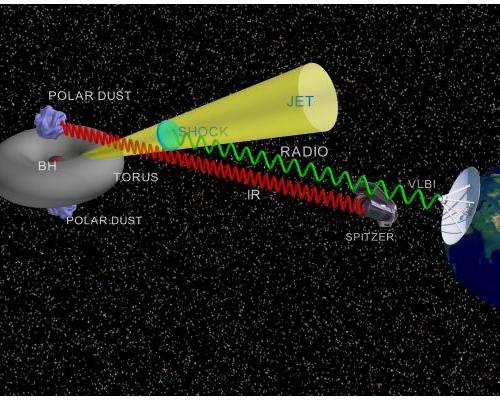This web page is created within BALTICS project funded from the European Union’s Horizon2020 Research and Innovation Programme under grant agreement No.692257.
Irbene participate in stellar deaths research
2018. gada 30. jūnijs
Astronomers, working on a project to detect supernovas, made a surprise discovery when they found that one supernova explosion was actually a star being pulled apart by a supermassive black hole. This rare stellar death, known as a tidal disruption event, or TDE, occurs when the powerful gravity of a supermassive black hole rips apart a star that has wandered too close to the massive monster. Theorists have suggested that material pulled from the doomed star forms a rotating disk around the black hole, emitting intense X-rays and visible light, and launches jets of material outward from the poles of the disk close to the speed of light.
Originally, the researchers were monitoring a pair of colliding galaxies known as Arp 299, nearly 150 million light-years from Earth. This area of space is so rich in supernova explosions it has been dubbed the “supernova factory”. However, in January 2005 the researchers discovered a bright burst of infrared emission coming from the nucleus of one of these galaxies, and in July of the same year a new, distinct source of radio emission was witnessed from the same location.
Animated gif showing the first light at radio wavelengths of the TDE in Arp299B (=Arp299B-AT1) back in 2005, and following the jet formation and evolution with time for more than 10 years. The movie plays side by side, showing images at 5.0 GHz (left) and 8.4 GHz (right) obtained with a world array of radio telescopes, including the powerful European VLBI Network (EVN) and the Very Long Baseline Array (VLBA) of the NRAO. Bill Saxton, NRAO/AUI/NSF.
This extensive monitoring revealed in 2011 that the radio-emitting portion was expanding in one direction, forming an elongation called a jet, as previously predicted by theorists. The measured expansion indicated that the material in the jet moved at an average of one-fourth the speed of light.
Such events may have been more common in the distant Universe, so studying them could help scientists to better understand the environment in which galaxies developed billions of years ago.
Information obtained from http://www.jive.eu/
Full article: http://www.jive.eu/surprise-discovery-provides-new-insights-stellar-deaths




















